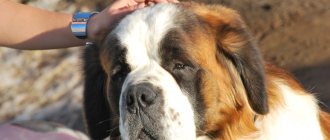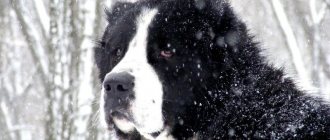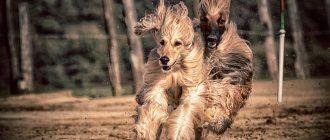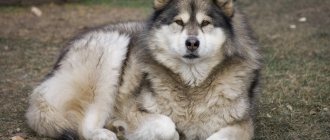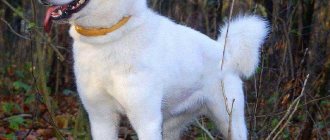Basic moments
Saint Bernards are natives of the Swiss Alps, selfless rescuers of travelers lost in the mountains, known for their phenomenal devotion to people. Serious and collected, these white-red giants are completely devoid of arrogance and the desire to “show off” in front of their relatives. And what’s the point of proving something to someone with such impressive dimensions. Saint Bernards feel most comfortable in large, friendly families, where they are certainly not threatened by loneliness and lack of communication.
History of the Saint Bernard breed
The history of the formation of the breed goes back so far that experts can only speculate as to who actually was the ancestor of rescue dogs. Most modern researchers are inclined to believe that the ancestors of today's St. Bernards were Tibetan Great Danes - massively built dogs that settled throughout Central and Asia Minor in the 4th century BC. e. The animals came to Europe with the convoys of Alexander the Great, who brought them as war trophies, first to Greece, and then to Ancient Rome. However, some scientists continue to consider St. Bernards to be the “product” of mating a Great Dane with a Mastiff.
As for the name of the breed, the animals owe it to the Catholic saint Bernard of Menton, who founded a kind of shelter for travelers and pilgrims in the Swiss Alps. The establishment was located on the Great St. Bernard Pass, known for its extreme weather conditions and steep descents. Due to constant avalanches and crumbling mountain slopes, the trip to Bernard's shelter was a real game of survival. As a result, the monks of the local monastery often had to arm themselves with shovels and, instead of prayers and night vigils, go in search of tourists freezing under snowdrifts.
In the 17th century, the first St. Bernards began to be involved in rescue operations, which were bred directly at the monastery. The animals had thick skins, withstood the cold and had an excellent sense of smell, allowing them not only to smell a person under a snow pile, but also to predict the next avalanche. In addition, the dogs served as a living heating pad: having dug up the victim, the St. Bernard lay down next to him to warm him up and help him hold on until help arrived.
At the beginning of the 19th century, as a result of an unknown infection, most of the dogs in the monastery of St. Bernard died. Fearing the complete extinction of the breed, the monks decided to “pump up” its surviving representatives with Newfoundland genes. However, the experiment was only half a success. The offspring born after such a mating looked more impressive due to their shaggy coat, but turned out to be completely unsuitable for working in the mountains. Snow stuck to the long hair of the mestizos, which is why the dog’s “fur coat” quickly became wet and became covered with an ice crust. Ultimately, the monks sent the shaggy St. Bernards into the valleys, where they began to be used as guards. Short-haired animals continued to serve on mountain passes.
In 1884, the Saint Bernards had their own fan club, whose headquarters were located in Basel, Switzerland. And three years later, rescue dogs were included in the breed register, and a separate appearance standard was approved for them. In the USSR, St. Bernard breeding began only after the end of the Great Patriotic War, after several breeding animals were exported from Germany. At first, the dogs were used exclusively for crossing, which helped domestic breeders to develop such an interesting breed in all respects as the Moscow Watchdog.
In the 90s, breeders' interest in St. Bernards began to wane. In the conditions of a sharp change in the state system and a rethinking of the value system, good-natured and sedate giants were no longer valued. Aggressive bodyguard dogs have come into fashion, becoming a symbol of financial independence and assertiveness of their owners. The gradual revival of the breed began only in 1996, after the founding of the first National Club of St. Bernard Fans. The organization united several smaller clubs, as well as breeding nurseries, which set the goal of preserving and improving the breed, and, if possible, returning its lost popularity.
Source
Famous representatives of the Beethoven dog breed
After looking through history, you can learn about many famous dogs of the breed from the film “Beethoven”. Most of them have achieved recognition due to their working qualities, but there are representatives who have gained popularity for their appearance.
Saint Bernards in the Guinness Book of Records
The huge dog Benedictine entered the book of records for his enormous weight, which reached 140 kg! The dog Hercules, who weighed 128 kg and had a neck girth of 96.5 cm, is slightly inferior to his giant relative. It was the St. Bernards that were included in the book as one of the strongest dogs in the world. The male Raittes Brandy Bear and the female Barbara managed to drag more than 2 tons of weight.
Barry, known throughout the world, became a record-breaking rescuer, because during his life he managed to pull 40 people out of the clutches of death. He lived in the 1800s at the Saint Bernard Monastery. The most famous rescue story was how Barry pulled a little boy from an ice cave whose mother had died in an avalanche.
"Little Bear" on a Norwegian ship
In the middle of the last century, a small St. Bernard appeared in the family of a whaling ship captain, who was named Bamsi, which means “little bear.” During the Second World War, the already experienced tailed sailor serves on a patrol ship of the Norwegian army. He became famous for carefully guarding his comrades, rescuing them from various troubles, and reconciling them during quarrels. The government made Bamsi a symbol of the Norwegian resistance, and after his death a monument was erected to the faithful dog.
Film actors and heroes of works of fiction
- Stephen King wrote a wonderful book about a St. Bernard, Cujo , who contracted a serious illness. A film was made based on this book.
- Astrid Lingren, in his work “ On the Island of Saltkrok, ” mentioned the pet of one of the heroines, who also belongs to the St. Bernard breed.
- The St. Bernard-Collie mix became one of the heroes of Jack London's The Call of the Wild
- St. Bernard Lel was one of the key characters in the Strugatsky brothers’ story “ Hotel “At the Dead Climber” .”
- Felix is the Family's Best Friend was released , the main character of which was a representative of this strong breed.
- The heroine of the Soviet film “ Where are you, Bagheera?” "became a spectacular St. Bernard.
- In the story of Peter Pan, there was a four-legged St. Bernard dog, Nana.
- Maxipes Fic was published in Czechoslovakia , describing the adventures of a giant St. Bernard.
You can buy a dog in a specialized nursery or from dog breeders. When buying a puppy, you should pay attention to the health and genetics of the parents, the conditions and environmental friendliness of their place of residence, and review the medical history. The price of a St. Bernard varies depending on the region, its terrain and the demand for the breed. The average price for a puppy in a St. Bernard nursery reaches $1,500-2,000.
By purchasing a St. Bernard from a breeder, you can reduce the price a little, but you should carefully study the documents and pedigree of the puppy. The cost of this dog is a life full of impressions and joy for both you and your family.
St. Bernard puppy playing with a cat
Saint Bernard is a guard dog , a good friend, protector and assistant. Purchasing a puppy of this breed will become an event in your life, and the dog will become a member of the family. Discipline, intelligence and self-control are the hallmarks of the Sen's character, which, together with kindness and love, makes the dog ideal for a large family or an elderly couple. There are many stories about the exploits of these dogs, and if you decide to get a St. Bernard, you will get a loyal friend and a good protector.
“Beethoven” is a faithful friend both in cinema and in life
The film “Beethoven” (USA), its first part, directed by B. Levant, was released in 1992. But the story here is not about the composer Beethoven, as someone might think: it is a kind, family comedy, a film about a dog. What breed of dog plays the title role in the film? Let's talk about this in more detail. The hero of the picture is a St. Bernard. A total of 6 parts of the film were released, but the first two turned out to be the most popular among viewers. It can rightfully be considered that the main role is assigned to this dog. The film featured a real purebred dog, captivating people with its good nature. A Saint Bernard starred in “Beethoven 2” with his puppies. The casting for the latter (and there are 4 of them in the film), according to the producers, was tough and there were about a hundred applicants.
Description of the breed
Saint Bernards are quite large, but at the same time they are rightly considered balanced and friendly animals. The coat can have different colors, however, in “Beethoven” a white dog plays, “colored” with yellow-brown spots. The breed of dog from the film “Beethoven” is quite in demand, and especially became so after the premiere of the film. This giant dog has conquered millions of hearts around the world. During the release of the movie, after watching it, children asked their parents to get them an animal of this breed. The Saint Bernard is considered a family dog; he is gentle, although not playful, dignified, loyal, and very patient. Animals are either short-haired or, on the contrary, long-haired. The color invariably contains white spots, and the base color is yellow-brown. The dog has quite developed, powerful muscles, the breed is very strong and courageous.
Famous representatives of the Beethoven dog breed
After looking through history, you can learn about many famous dogs of the breed from the film “Beethoven”. Most of them have achieved recognition due to their working qualities, but there are representatives who have gained popularity for their appearance.
Saint Bernards in the Guinness Book of Records
The huge dog Benedictine entered the book of records for his enormous weight, which reached 140 kg!
The dog Hercules, who weighed 128 kg and had a neck girth of 96.5 cm, is slightly inferior to his giant relative. It was the St. Bernards that were included in the book as one of the strongest dogs in the world. The male Raittes Brandy Bear and the female Barbara managed to drag more than 2 tons of weight.
Barry, known throughout the world, became a record-breaking rescuer, because during his life he managed to pull 40 people out of the clutches of death. He lived in the 1800s at the Saint Bernard Monastery. The most famous rescue story was how Barry pulled a little boy from an ice cave whose mother had died in an avalanche.
"Little Bear" on a Norwegian ship
In the middle of the last century, a small St. Bernard appeared in the family of a whaling ship captain, who was named Bamsi, which means “little bear.” During the Second World War, the already experienced tailed sailor serves on a patrol ship of the Norwegian army. He became famous for carefully guarding his comrades, rescuing them from various troubles, and reconciling them during quarrels. The government made Bamsi a symbol of the Norwegian resistance, and after his death a monument was erected to the faithful dog.
Film actors and heroes of works of fiction
- Stephen King wrote a wonderful book about a St. Bernard, Cujo , who contracted a serious illness. A film was made based on this book.
- Astrid Lingren, in his work “ On the Island of Saltkrok, ” mentioned the pet of one of the heroines, who also belongs to the St. Bernard breed.
- The St. Bernard-Collie mix became one of the heroes of Jack London's The Call of the Wild
- St. Bernard Lel was one of the key characters in the Strugatsky brothers’ story “ Hotel “At the Dead Climber” .”
- Felix is the Family's Best Friend was released , the main character of which was a representative of this strong breed.
- The heroine of the Soviet film “ Where are you, Bagheera?” "became a spectacular St. Bernard.
- In the story of Peter Pan, there was a four-legged St. Bernard dog, Nana.
- Maxipes Fic was published in Czechoslovakia , describing the adventures of a giant St. Bernard.
Features and character
The animal doesn’t care about the heat: on the contrary, it likes cold weather, so it needs access to the yard.
Most St. Bernards are prone to drooling. They are very obedient, have absolutely no conflicts and will never allow themselves to disobey their beloved owner. Such dogs are naughty only when they are babies. An adult St. Bernard behaves with dignity, shows good manners and calmness. Saint Bernard loves children, he is also called a children's nanny.
Children can cuddle, ride on this dog, kiss and hug it - Beethoven likes all the joyful manifestations of feelings coming from the owners. What kind of dog would allow himself to be treated like this? In fact, there are not many breeds similar in character.
Beethoven is always ready to help both his masters and strangers, in general, everyone who needs it. This is an invincible friend and protector in dangerous situations (whether an attack on the owner, robbery, etc.).
The Saint Bernard gets along well not only with children, but also with animals: he communicates without problems with cats, horses and representatives of his dog tribe. And most importantly: do not leave your St. Bernard alone for a long time. Loneliness is difficult for a dog to endure, and it greatly “traumatizes” it.
Appearance and standard
The standard for the Saint Bernard breed according to the International Canine FCI was first registered in 1830. Since then, several changes have been recorded, but since 1993, no amendments have been made to the breed documents for a long time. Currently, FCI Standard No. 61 is in force (01/21/2004), which provides for:
- two types of breed - short-haired and long-haired dogs;
- The Saint Bernard must have a harmonious, powerful, muscular body, an impressive head with attentive, friendly or wary eyes;
- The dog's character is friendly, its temperament is calm, alert, active;
- on the dog’s evenly wide muzzle there should be a black nose with wide open nostrils, moderately set eyes with irises from dark brown to hazel;
- elastic ears are located on the head in the form of a triangle rounded at the top, the front edge of the ears should be adjacent to the cheekbones;
- The dog's belly should be tucked up, the back straight, the croup long, turning into a wide, strong long tail, reaching the hock joint.
Griffon (dog): Brussels Smooth-haired breed
The St. Bernard's well-proportioned body, powerful skeleton, strong paws, thick, close-fitting coat of a basic white-red color should be complemented by red-brown or dark brown spots and white markings on the chest, paws, end of the tail, around the nose, on the forehead, and on the back of the neck.
Important! The dog's weight can reach 90 kg, height at the withers is 90 cm. The life expectancy of the Saint Bernard breed is on average 7-9 years.
Saint Bernard male
Animal intelligence
The dog is not small.
At the same time, she almost always has some kind of sad expression on her face. Therefore, most people believe that St. Bernards are not very smart. What is fundamentally wrong: animals are highly intelligent, they have a quick reaction, they are endowed with the ability to make the right decision very quickly. Selflessly loving their owners, St. Bernards try in any way to please and please them. That is why training these dogs is quite easy. At the same time, both the animal itself and its owner receive pleasure.
How else does Beethoven's high intelligence manifest itself? The dog has an excellent sense of direction: this quality is genetically embedded in it. When you get ready to go on a hike, know: you will not find a better companion and companion than this beautiful and devoted dog.
No matter how difficult the hiking situation may be, the St. Bernard will always lead you home.
Hachiko's story: a true story about the devotion and love of a four-legged pet
Japanese Fighting Dog: Loyal, Hardy Protector and Companion
How to walk your dog?
The Japanese Chin is a sweet and kind dog for those who need a good friend
Source
About the breed
What breed of dog was Beethoven? Beethoven is a Saint Bernard or Alpine Mastiff, a huge breed that originated in Switzerland and Italy. They are named after the Great St. Bernard Pass on the Italian-Swiss border, where they were bred to provide aid and save people.
How big are they? They weigh from 65 to 120 kg, and sometimes more. Their height is 70 to 90 cm. They are powerful and strong, which makes them ideal dogs for rescuing people in the mountains. They take two or three years to grow to their final size.
They are calm, sweet, patient and friendly. They get along well with people and children and are suitable for training.
Where did the name of the dog breed come from?
Saint Bernard means "Saint Bernard" in French. In the Alps, on the Mons Jovis pass, there was a monastic shelter, the founder of which was the son of a French baron, who ran away from home almost immediately after graduating. While studying in Paris, he became interested in theology and chose serving God instead of a well-fed and rich family life. He founded a shelter that had about 100 rooms for weary travelers.
Young, healthy and strong men were selected to serve in such a monastery, because they had to live in harsh natural conditions. Is it any wonder that the monks chose equally hardy and strong animals as their assistants? It was in this monastery shelter that the standard of St. Bernards was bred, which were used to save people.
Interestingly, the shelter only housed males. The bitches and puppies lived in the valley. Before going to work, the dogs were trained, strengthening such qualities as reliability, endurance, strength, and obedience.
About the dog starring in the film
The main star of the first two films was the 90-pound St. Bernard, Chris. One of his trainers said that he liked to be “lazy,” drooling, and hanging around the house.
Finding the perfect dog for this role was not easy, I had to spend several months and look at more than twenty different St. Bernards before finding the right one. Also, part of the script had to be rethought, because initially a golden retriever was considered for the main role, and St. Bernards are not so dexterous and energetic.
Unfortunately, giant dog breeds have a short lifespan, and Chris passed away after the second film. He was 12 years old when he died, which is actually not so young, since many St. Bernards live even shorter.
In other parts, other dogs of the same breed were filmed.
Detailed video about Saint Bernards
Source
Maintenance and care
A prerequisite for the breed is the presence of a large, free territory, mainly in its home. The apartment for such a dog is cramped and uncomfortable.
The best option is to organize an enclosure and equip the booth well. The pet needs safety: to do this, you need to remove objects from the access area that can hurt or chew, and cover the slippery floor. It is not necessary to maintain a certain temperature regime for the St. Bernard, since this breed of dog is northern and is not afraid of frost and snow. In the summer, they need to be protected - overheating and heat stroke are possible.
There is no need for special walking for dogs kept in the house. The St. Bernard needs fresh air, limited exercise, and regular socialization. After walks, it is advisable to inspect the paw pads, if there are wounds, treat them, and remove stuck foreign objects.
Grooming your dog should include weekly cleaning of the ears with cotton balls. The vulnerable spot is the eyes, which are prone to inflammation. It is important to wipe them with a clean gauze cloth after each walk and remove mucous secretions.
The disadvantage of the breed is heavy shedding and a large amount of wool. To soften it, it is recommended to use special combs and brushes for combing every day, to prevent the appearance of “tangles”. A healthy four-legged pet should not have an unpleasant, foul smell coming from its fur. If it appears, it is necessary to check its health status, analyze its nutrition, and examine its skin and coat for signs of illness.
Vaccination of the breed is important: the first vaccination is given at 2 months. Then again every quarter, six months and year. If you have illnesses or feel unwell, the veterinarian makes a medical referral. Before vaccination, treatment against worms is required 2 weeks before vaccination. For each representative of the breed, it is better to draw up a schedule with a specialist.
Voronezh star
Beethoven comes into the Newton family as a puppy. It was supposed to be played by a dog that looked like an adult dog. Casting animals is a long and difficult process; you need to choose a dog that is not only similar in appearance, but also has the necessary temperament, intelligence, sociability, clearly follows commands and at the same time be a playful and funny puppy.
For the role of Beethoven's puppy, they chose a representative of the breed, who at that moment came to the exhibition from Voronezh. His owner was a famous Russian St. Bernard breeder.
The puppy had to obey not only the trainer, but also the director. The widow of the American comedian Buster Keaton, Eleanor Keaton, took on this difficult task. She accompanied the dog actors on the set of all episodes, starting with the first. She taught them how to behave on camera, played with them, maintained a positive mood and achieved the necessary actions.
Saint Bernards have a high level of intelligence and a natural sense of danger, because they were bred to help people. They will never show aggression, no matter what children do to them.
She managed to show the breed in such a way that later many families who had their own plot and house got themselves a St. Bernard puppy. This is the merit of the “Voronezh star”. In the early 90s. this breed has become the most popular in America and famous in the world.
The puppy in the film received this name because he helped his little owner perform Beethoven's work - he barked while she played the piano.
Intelligence of St. Bernards
Numerous positive reviews from viewers and the increased popularity of the breed speak about the canine intelligence of the dogs that coped with the difficult role of Beethoven’s St. Bernard. Good-natured dogs who value people’s lives above their own can be cunning, simpletons, couch potatoes, and very active.
Which dog matches a person's zodiac sign?
They cannot be accommodated in a small apartment, but a large open loggia, protected from the sun's rays, will become their own den, into which the owners will never be prohibited from entering. Dogs cannot stand heat, but they are not afraid of frost.
Note! St. Bernards will feel best in a separate dog enclosure with a booth that is suitable for their body size.
Dog owners should be aware that even though the Saint Bernard breed was created to help people, Saint Bernard dogs still have their own views on people and the world around them. Unquestioning obedience to a person will only happen if the puppy is raised from a very early age, accustomed to living with people, and trained. For dogs, it is even important what intonation and what voice people use to communicate with them.
Saint Bernards are big couch potatoes
Smart bully
The character of the St. Bernard is balanced, calm and patient. The size of dogs is such that it is impossible to imagine any other behavior. Weight – under 100 kg, height at the withers – up to 90 cm.
In the film, Beethoven, a purebred St. Bernard named Chris, appears as a real bully. He steals food from the table, jumps over it, jumps out the window, and performs actions that you would not expect from a St. Bernard. He learned to pose, play for the camera, and also fall, pretending to be dead at Eleanor's command. The film crew chose a dog from 12 applicants and chose the most cheerful, restless and intelligent one - Chris.
This behavior is uncharacteristic of the breed, but the filmmakers decided that this was the dog they needed so that the audience would fall in love with him, just like the fictional owners.
In the film's sequels, Chris had to hire stunt doubles to stay healthy. Eating bacon 5-7 times in a row is very harmful for one dog.
Breed standard
Saint Bernard belongs to the large breeds of the raw type. These are powerful animals, they come in soft-haired and hard-haired varieties. The weight of adults is about 70 kg , height is 70-90 cm .
A large head rests on a powerful neck with a slight dewlap. The skull is short, the forehead is convex. Small, medium-length, drooping ears. Brown eyes, not deep set, slightly sunken. Eyelids are damp. The muzzle is short, with a blunt bridge of the nose. The nose is wide, black in color with flat nostrils. The jaws are massive.
The physique is powerful, the back is wide. The limbs are widely spaced, muscular and straight. The paws are massive, with arched toes. The tail is weighted and long. In a calm state, the dog keeps it lowered down; in an excited state, he twists it up.
There are two types of St. Bernards based on their coat type: long-haired and short-haired:
1. Long-haired – the coat is long and soft. Light curls are allowed at the bottom. There is a thick undercoat. “Pants” and “skirt” of medium length. A characteristic feature of the breed is the fluffy collar. The hair on the face and ears is shortened. 2. Short-haired - the coat is short, the guard hair is hard. There is a dense undercoat.
Selection of puppies
The audience loved the first film so much that several sequels were made. In the second part of the film, Beethoven finds his love - the St. Bernard girl Missy, and according to the plot, they have puppies.
Even more dogs were now needed for filming. The film crew needed to view more than 100 St. Bernard puppies 7 weeks old or older. Puppies with shaggy and smooth hair, like the main characters, were required.
Missy is a girl, more balanced and calm, neat, with smooth fur. Beethoven is playful, funny, his shaggy fur adds to his hooligan look. Both types - shorthair and longhair - are breed standards. Therefore, puppies were also required, different in age and appearance. All were then returned to the owners.
Source
Choosing a name for a star dog
For people, when choosing a name for their pet, it is important to identify its character traits and appearance features. It is easier for dogs to remember short combinations of common sounds. Based on this, experts suggest the following names for large, good-natured St. Bernards:
- for males - Andri, Umka, Bruce, Jerry, Bartley, Uranus, Willie, John, Zidane, Karl, Claude, Sultan, Christophe, Matthias, Rex, Simon, Tima, Tis, Volt, Luke, Green, Polkan, Baron, Count , Uranus;
- for females - Bucky, Bebba, Zara, Isa, Gina, Veta, Cassie, Eva, Bonya, Molly, Dina, Tori, Daisy, Lily, Poly, Vesta, Busya, Vicky, Vega, Linda, Alba, Zhulya, Marie, Lucky , Vesta.
Accustoming a St. Bernard puppy to a nickname is quite simple and quick, the main thing is that the dog’s name is liked not by the dog, but by people.
In order for the family to grow with a good-natured, people-loving pet, whose weight and size may simply not fit into the dimensions of the home, it is necessary to carefully analyze everything. After all, even the kindest dog can become a burden, and dogs of the Saint Bernard breed should only be pets. They deserve it.
What breed is the main pet in the movie Beethoven? Main features of dogs +Video
What breed of dog became the main character in the American film "Beethoven"?
Beethoven's breed is St. Bernard. A real dog of this breed was involved in the filming process - white and red. The appearance in the house of the respectable Newton family with strict regulations of a puppy, who unexpectedly protected from death, and fell in love, at once, with three young children. This event turned everything upside down.
The dog tries to live according to regulations, sometimes he does harm, he loves the whole family and is ready to sacrifice his own life for their sake.
History of the breed
The breed bears the name of the hermit Bernard, who became the founder of a refuge in the Alps for wanderers on a mountain ridge, later known as Grand Saint Bernard. The monastery was a kind of refuge from hurricanes, landslides, bone-chilling winds and gangs of thieves.
There, by crossing with Tibetan mastiffs, they got dogs that adapted to the local climate. They foresaw the proximity of an avalanche and landslides, and protected the inhabitants of the monastery. The Saint Bernards were sent by monks to search the snowy slopes and avalanches for lost travelers.
The St. Bernard rescuers were equipped with knapsacks and small barrels of boiling water to warm the sufferers.
Saint Bernards did not give up in battles with bears, protecting people. But it rarely came to bloodshed; the beast was intimidated, and he retreated.
The instinctive beginnings of the breed still live in these heroes - they will never be denied salvation. Having noticed someone lying on his face, the dogs will turn him over onto his back and check his breathing. In case of failure, they will simply lie nearby, warming and barking, and will attract attention.
Description
The breed looks intimidating in appearance due to its large size, but by nature these dogs are sensitive and gentle. They are friendly to people and children and will never cause harm. They are tolerant of animals: cats, dogs, and other pets can easily live in the house with them.
The main characteristics of the breed are intelligence, intelligence, insight, and trainability. From a young age, dogs understand verbal commands and capture the mood of the trainer and owner.
An adult St. Bernard is calm and balanced, despite its menacing appearance. The second feature is often used for domestic needs.
Such a dog is a good watchman and can scare away thieves from the house. She is not characterized by aggressiveness, hostility, or bitterness.
The character of a St. Bernard depends on training and education. From childhood, he needs to instill good qualities, teach the rules of behavior - is it possible to sleep and live in the house, lie on the bed.
An avid dog lover. Experience in veterinary medicine since 2009.
The worst thing for a four-legged friend is loneliness. He needs communication with his owner, frequent walks, games, and activities. Without the constant presence of a person, the animal becomes sad, gets sick, and can inflict serious wounds on itself.
Character
Outwardly, scary individuals are endowed with a good way of life, their devotion to the owner is limitless, they are well trained, and in a leisurely environment they give the impression of being louts. They note their tender feelings towards the baby.
Advantages:
Flaws:
Saint Bernards will not tolerate aggressiveness or anger, and require gentle handling during training or will be stubborn. Life expectancy is up to eight years.
Functions performed: escort; rescue operations in the deepest snow; carrying heavy objects; security, guarding.
Currently, they are protection and wonderful friends, rescuers, watchmen.
They require a huge area for walking. They will feel uncomfortable in an apartment building due to the heat and lack of territory. For this reason, the best place to live is a country house, the opportunity for quality walking with mandatory physical exercise.
One can only envy the endurance of the breed - they can easily endure cold and heat, their psycho-emotional state is very stable. Complete absence of aggression towards strangers for no reason, sensitive to the owner’s mood - they will support, distract, and are very intelligent.
Puppies with almost no visible sexual type, with short legs, without snow-white spots where they are prescribed by the GOST of the breed are considered to be defective. St. Bernards with eyes similar in configuration to almonds and a lightish color of the rainbow space, a strongly curled tail and a tail thrown over the back are not allowed. Curly fur, a sagging and hunched back, very noticeable folds on the frontal and neck parts do not paint the breed, on the other hand, they are not recognized as a significant argument for eliminating a pet.
At exhibitions, timid or deliberately aggressive, mono-colored pets, with an incorrectly formed bite, eversion of the eyelids and blue eyes are not allowed. Another small size of the animal and psycho-emotional disharmony.
Where can I buy
The price of St. Bernard puppies depends on their pedigree, participation in exhibitions and the working qualities of their ancestors.
You can buy two-month-old animals from nurseries for around fifteen to twenty thousand rubles, provided that these are not purebred pets. There are an abundance of advertisements starting from five thousand, but there, most likely, the animals have some kind of deformity. An adult with good pedigree and training is estimated at fifty thousand rubles.
Before getting a pet, it is recommended to weigh the pros and cons and familiarize yourself with its characteristics in detail. The dogs in the photo are more than cute. But can you provide him with full content? If yes, then your choice will bring only joy to both parties!
Source
